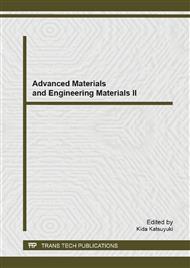[6]
] Gu Siyan. Machine vision technology and application of Line, D. Guangzhou: Guangdong University of Technology, Faculty of Automation, 2011. , also is to make Eq. 1minimum. E=i=1N(axi+b-yi)2. (1) Line Detection with Hough Transform. Hough transform use the parametric equation of the straight line as Eq. 2. In the formula, represent straight line direction, 0≤θ<180, represent distance which is origin to the linear. Line of different points in the parameter plane ρ –θ is transformed for a bunch of intersection in a bit of sine curve. Obviously if this parameter plane of node is able to determine, line detection is realized. xcosθ+ysinθ=ρ. (2) The Algorithm Analysis and Comparison. Acquisition of the cross section profile image is extracted several straight line segment through a series of software process which are image preprocessing, image analysis and linear segment fitting. In the images the linear and angular point are extracted and fitted, and get the a few pieces of the main straight line segment characteristics in image through the conversion and calculation of coordinate system. Fig. 2 and Fig. 3 are extracting features of the image respectively based on the least squares and the Hough transformation. Least squares method in theory can obtain a given data set in the mean square error of the sense of absolute precision straight line, so as to reach a high precision. But least squares is very vulnerable to the effects of noise and breakpoint, as shown in Fig. 2, the line of web width is quasi synthesis for three straight line segment. And Hough transform has good robustness, can steadily and accurately detect the main straight line segment. The flexible section of roll forming product is not complex, and two kinds of algorithm are can satisfy the requirement of real-time. In order to ensure the reliability of the testing, the system's feature extraction algorithm uses Hough transform to detect. Fig. 2 Effect chart based on least squares Fig. 3 Effect chart based on Hough transform Matrix Mapping Analysis of Profile Image If the rotation and scaling are all present, its linear mapping relationship is indicated by Eq. 3. Deviation value for Angular and length are got by above formula, in order to the system controls motors to compensate the value in the next cycle of motion compensation. sigi'=μ(cosθsinθ-sinθcosθ)∙sigi. (3) Deviation value of sheet section angle and length can be expressed as Eq. 4. fμi, θi=μili+θiπD/360. (4) In Eq. 4, μi represents the line length scaling of profile section for the nth pass, θi represents the line angle scaling of profile section for the nth pass, li represents the line length of profile section for the nth pass, D represents the rotating diameter. Experimental Results and Conclusion To detect whether online visual inspection system for flexible roll forming meets the demand for practical production by the experiment. The selection for sheet metal forming shape as shown in Fig. 4, A-A is the largest section of sheet section view. (a) Vertical view of sheet metal profile (b) The largest section of sheet section view Fig. 4 Size drawing of sheet metal forming Experiment 1 The experimental system uses visual feedback system for on-line monitoring of flexible roll forming. X direction speed of experimental sheet material is 30 mm/s. Image acquisition cycle is 1s. Sheet thickness is 0. 6mm and model is Q235. The number for forming passes is 7. Image acquisition system chooses 3 million pixels CCD industrial camera, and 650NM laser generator. Molding product is shown in Fig. 5. Fig. 5 Molding product of experiment 1 Experiment 2 The experimental system uses traditional feedback control system of flexible roll forming. X direction speed of experimental sheet material is 30 mm/s. Sheet thickness is 0. 6mm and model is Q235. The number for forming passes is 7. Molding product is shown in Fig. 6. Fig. 6 Molding product of experiment 2 After repeated experiments, a conclusion can be drawn that the visual feedback system for on-line monitoring of flexible roll forming is a kind of effective and reliable method of controlling precision in flexible roll forming. And this method is applied for the forming of simple and rather complex cross-section. Ten pieces of finished products was taken from each group of experiment 1 and experimental 2, and finished product was taken 10 same measuring point which can reflect the precision of sheet forming. The mean value at the 10 point for each finished product is precision of sheet metal forming at corresponding point. Error measuring results as is shown in Table 1. Table 1 Results comparison of error measuring (mm) Group number 1 2 3 4 5 6 7 8 9 10 Standard deviation Experiment1.
Google Scholar
0549 After repeated experiments, a conclusion can be drawn that the visual feedback system for on-line monitoring is improves accuracy of the flexible roll forming. And this method is applied for the forming of simple and rather complex cross-section. Acknowledgment This paper is supported by the National Science & Technology Pillar Program High strength steel advanced forming technology and its objective model integrated application (2011BAG03B03), and the Beijing Training Foundation Project for Excellent Talents, China (2010D005002000005).
Google Scholar


